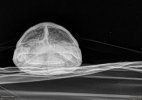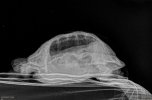EgyptianSaikou
New Member
Hi everyone, this is my first post but I’ve been reading and learning from this forum for a while. I found a topic which I think is interesting to be discussed. But before I start, I just want to say thank you to all the experienced members on this forum. Your suggestions saved my life, while you don't even know!
So here’s my story:
Yesterday morning when I was soaking my 2 year old Egyptian tortoise, he flashed as usual but then I noticed there’s a little bit of blood in the water.
At the moment I was thinking of bladder stone but he soon passed a very soft urate which looked totally fine to me. So my second thought was that blood might come from his digestion system.
Today, I took him to an animal clinic focusing on small mammals, reptiles, and birds. And here’s the x-ray images of my poor boy:



As you can see, in his body there are small pieces of oyster shell which is initially produced for small birds. It is quite commonly used by tortoise keepers as a good calcium source. However, the sharp edges of these became a hazard to his stomach and intestines, and also the “man part”. The doctor said the fragments will eventually get through his body but could make scratches during the process. And she believed that the blood I saw yesterday was caused by one piece of oyster shell that scratched his penis when he was trying to poop.
Question: I’ve seen some posts saying oyster shell will dissolve during digestion process. And from the x-ray images, the fragments only exist in the up-half of the body (I guess only in stomach?) This makes me confused. If any people have experience or knowledge on this topic, I would be very appreciated!
Another question: how does the “man part” of a male tortoise hide back in the tail? Coz every time I saw him poops, he will always take out his “part” first in order to push his stool out. And yes, his poop is round and firm, and quite big comparing to his body size. So does this happen to other species in male? This seems a very “inconvenient” function to me 😂
Anyway, I’m glad he’s not having any bladder stones and the doctor said his lungs look great! The only thing I need to do is removing all the oyster shells in his enclosure and waiting him to pass all the little pieces in his body. I think this is an interesting topic of how tortoises digest oyster shells. But personally I will no longer put any hard pieces of stones (like sand, small or large pieces of oyster shell crushes) that he could swallow. I will use cuttle bone and calcium powder only.
Also, if you guys have any observation from the x-ray images, please don't hesitate to point out! Gracias!
So here’s my story:
Yesterday morning when I was soaking my 2 year old Egyptian tortoise, he flashed as usual but then I noticed there’s a little bit of blood in the water.
At the moment I was thinking of bladder stone but he soon passed a very soft urate which looked totally fine to me. So my second thought was that blood might come from his digestion system.
Today, I took him to an animal clinic focusing on small mammals, reptiles, and birds. And here’s the x-ray images of my poor boy:



As you can see, in his body there are small pieces of oyster shell which is initially produced for small birds. It is quite commonly used by tortoise keepers as a good calcium source. However, the sharp edges of these became a hazard to his stomach and intestines, and also the “man part”. The doctor said the fragments will eventually get through his body but could make scratches during the process. And she believed that the blood I saw yesterday was caused by one piece of oyster shell that scratched his penis when he was trying to poop.
Question: I’ve seen some posts saying oyster shell will dissolve during digestion process. And from the x-ray images, the fragments only exist in the up-half of the body (I guess only in stomach?) This makes me confused. If any people have experience or knowledge on this topic, I would be very appreciated!
Another question: how does the “man part” of a male tortoise hide back in the tail? Coz every time I saw him poops, he will always take out his “part” first in order to push his stool out. And yes, his poop is round and firm, and quite big comparing to his body size. So does this happen to other species in male? This seems a very “inconvenient” function to me 😂
Anyway, I’m glad he’s not having any bladder stones and the doctor said his lungs look great! The only thing I need to do is removing all the oyster shells in his enclosure and waiting him to pass all the little pieces in his body. I think this is an interesting topic of how tortoises digest oyster shells. But personally I will no longer put any hard pieces of stones (like sand, small or large pieces of oyster shell crushes) that he could swallow. I will use cuttle bone and calcium powder only.
Also, if you guys have any observation from the x-ray images, please don't hesitate to point out! Gracias!